Gibbs Reflection on Wound Care: A Clinical Skills Assessment
VerifiedAdded on 2022/11/24
|5
|1034
|498
Practical Assignment
AI Summary
This Gibbs Reflection details a nursing student's experience during a clinical skills assessment involving wound care for a patient with a venous ulcer. The student describes the encounter, highlighting both positive aspects such as therapeutic communication and hand hygiene, and negative aspects such as excessive handwashing time, improper hand drying technique, and failure to respond to a patient's request. The reflection includes an evaluation of the experience, an analysis based on relevant literature, and a conclusion summarizing key learnings. The student identifies areas for improvement, including time management, hand hygiene practices, and patient prioritization, and outlines a detailed action plan to enhance clinical skills and patient care. The reflection emphasizes the importance of standard guidelines in wound care to prevent infection and promote faster recovery.
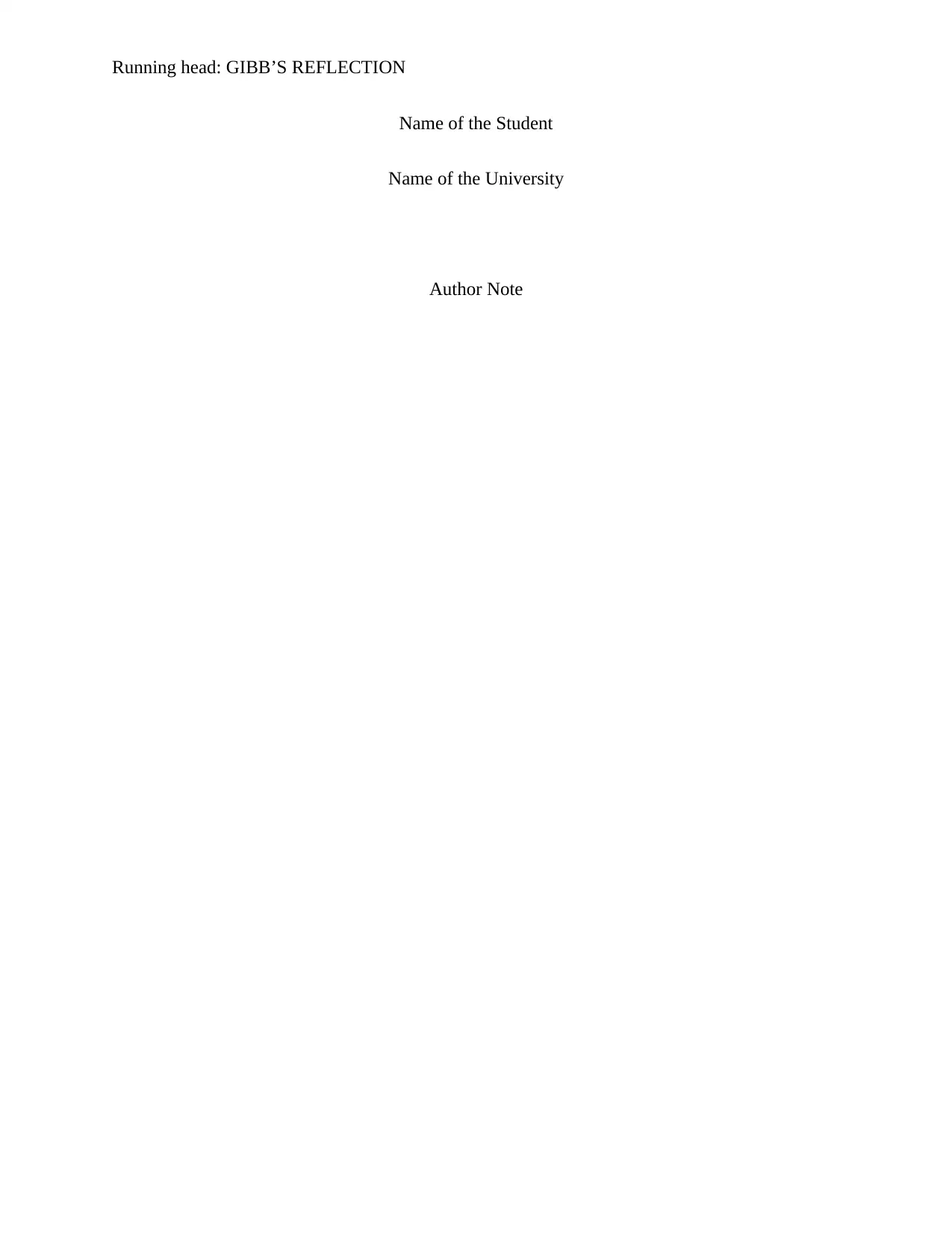
Running head: GIBB’S REFLECTION
Name of the Student
Name of the University
Author Note
Name of the Student
Name of the University
Author Note
Paraphrase This Document
Need a fresh take? Get an instant paraphrase of this document with our AI Paraphraser
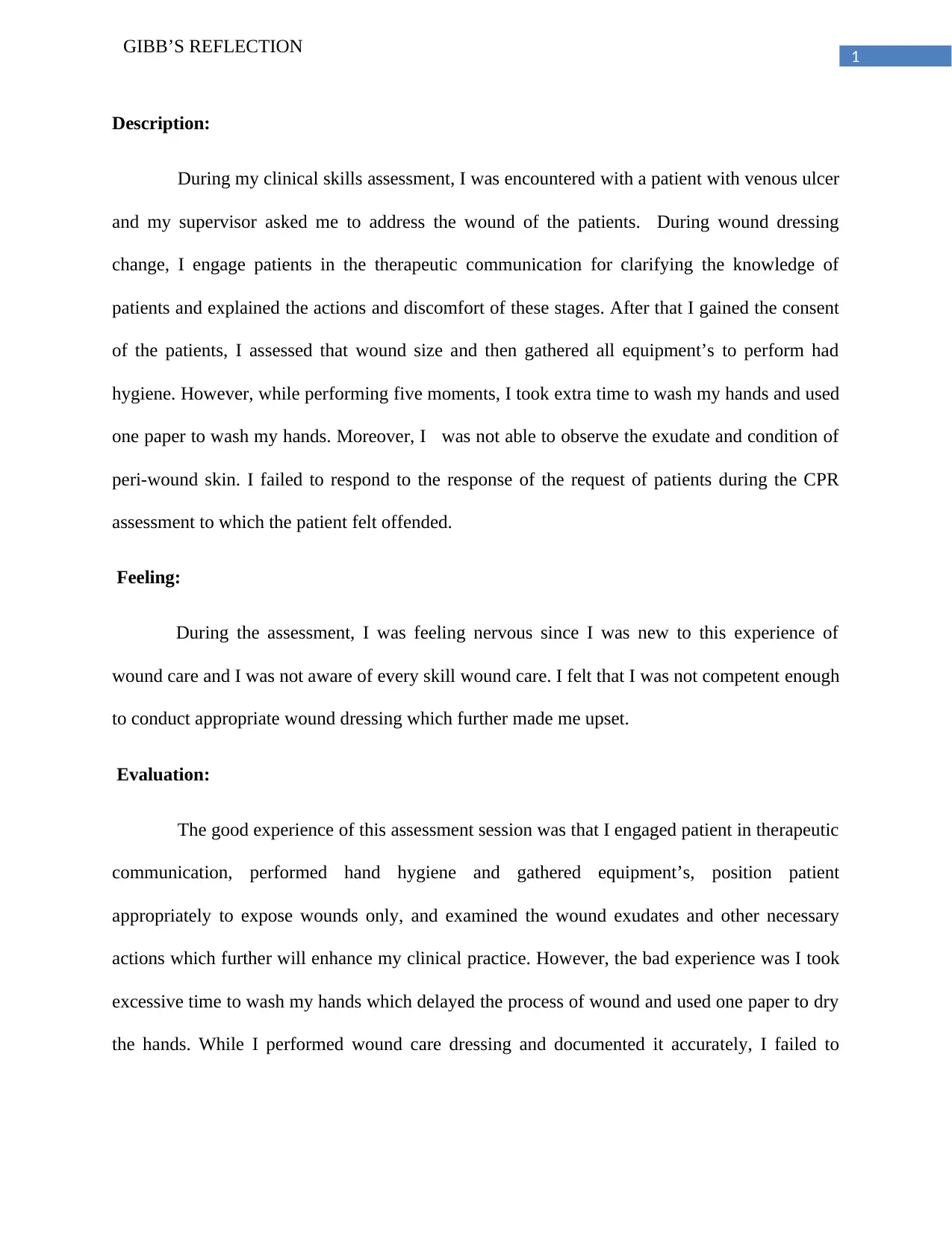
1
GIBB’S REFLECTION
Description:
During my clinical skills assessment, I was encountered with a patient with venous ulcer
and my supervisor asked me to address the wound of the patients. During wound dressing
change, I engage patients in the therapeutic communication for clarifying the knowledge of
patients and explained the actions and discomfort of these stages. After that I gained the consent
of the patients, I assessed that wound size and then gathered all equipment’s to perform had
hygiene. However, while performing five moments, I took extra time to wash my hands and used
one paper to wash my hands. Moreover, I was not able to observe the exudate and condition of
peri-wound skin. I failed to respond to the response of the request of patients during the CPR
assessment to which the patient felt offended.
Feeling:
During the assessment, I was feeling nervous since I was new to this experience of
wound care and I was not aware of every skill wound care. I felt that I was not competent enough
to conduct appropriate wound dressing which further made me upset.
Evaluation:
The good experience of this assessment session was that I engaged patient in therapeutic
communication, performed hand hygiene and gathered equipment’s, position patient
appropriately to expose wounds only, and examined the wound exudates and other necessary
actions which further will enhance my clinical practice. However, the bad experience was I took
excessive time to wash my hands which delayed the process of wound and used one paper to dry
the hands. While I performed wound care dressing and documented it accurately, I failed to
GIBB’S REFLECTION
Description:
During my clinical skills assessment, I was encountered with a patient with venous ulcer
and my supervisor asked me to address the wound of the patients. During wound dressing
change, I engage patients in the therapeutic communication for clarifying the knowledge of
patients and explained the actions and discomfort of these stages. After that I gained the consent
of the patients, I assessed that wound size and then gathered all equipment’s to perform had
hygiene. However, while performing five moments, I took extra time to wash my hands and used
one paper to wash my hands. Moreover, I was not able to observe the exudate and condition of
peri-wound skin. I failed to respond to the response of the request of patients during the CPR
assessment to which the patient felt offended.
Feeling:
During the assessment, I was feeling nervous since I was new to this experience of
wound care and I was not aware of every skill wound care. I felt that I was not competent enough
to conduct appropriate wound dressing which further made me upset.
Evaluation:
The good experience of this assessment session was that I engaged patient in therapeutic
communication, performed hand hygiene and gathered equipment’s, position patient
appropriately to expose wounds only, and examined the wound exudates and other necessary
actions which further will enhance my clinical practice. However, the bad experience was I took
excessive time to wash my hands which delayed the process of wound and used one paper to dry
the hands. While I performed wound care dressing and documented it accurately, I failed to
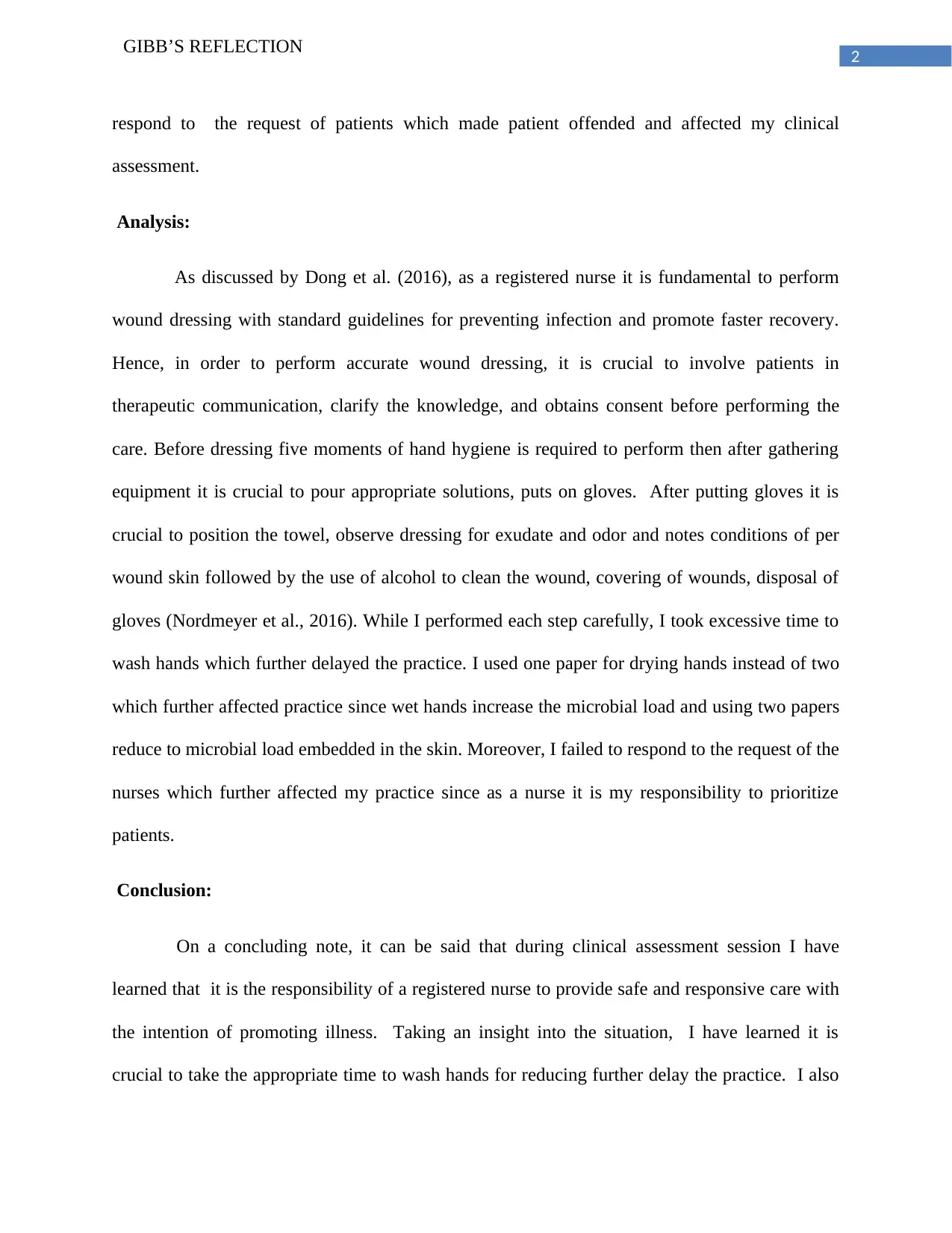
2
GIBB’S REFLECTION
respond to the request of patients which made patient offended and affected my clinical
assessment.
Analysis:
As discussed by Dong et al. (2016), as a registered nurse it is fundamental to perform
wound dressing with standard guidelines for preventing infection and promote faster recovery.
Hence, in order to perform accurate wound dressing, it is crucial to involve patients in
therapeutic communication, clarify the knowledge, and obtains consent before performing the
care. Before dressing five moments of hand hygiene is required to perform then after gathering
equipment it is crucial to pour appropriate solutions, puts on gloves. After putting gloves it is
crucial to position the towel, observe dressing for exudate and odor and notes conditions of per
wound skin followed by the use of alcohol to clean the wound, covering of wounds, disposal of
gloves (Nordmeyer et al., 2016). While I performed each step carefully, I took excessive time to
wash hands which further delayed the practice. I used one paper for drying hands instead of two
which further affected practice since wet hands increase the microbial load and using two papers
reduce to microbial load embedded in the skin. Moreover, I failed to respond to the request of the
nurses which further affected my practice since as a nurse it is my responsibility to prioritize
patients.
Conclusion:
On a concluding note, it can be said that during clinical assessment session I have
learned that it is the responsibility of a registered nurse to provide safe and responsive care with
the intention of promoting illness. Taking an insight into the situation, I have learned it is
crucial to take the appropriate time to wash hands for reducing further delay the practice. I also
GIBB’S REFLECTION
respond to the request of patients which made patient offended and affected my clinical
assessment.
Analysis:
As discussed by Dong et al. (2016), as a registered nurse it is fundamental to perform
wound dressing with standard guidelines for preventing infection and promote faster recovery.
Hence, in order to perform accurate wound dressing, it is crucial to involve patients in
therapeutic communication, clarify the knowledge, and obtains consent before performing the
care. Before dressing five moments of hand hygiene is required to perform then after gathering
equipment it is crucial to pour appropriate solutions, puts on gloves. After putting gloves it is
crucial to position the towel, observe dressing for exudate and odor and notes conditions of per
wound skin followed by the use of alcohol to clean the wound, covering of wounds, disposal of
gloves (Nordmeyer et al., 2016). While I performed each step carefully, I took excessive time to
wash hands which further delayed the practice. I used one paper for drying hands instead of two
which further affected practice since wet hands increase the microbial load and using two papers
reduce to microbial load embedded in the skin. Moreover, I failed to respond to the request of the
nurses which further affected my practice since as a nurse it is my responsibility to prioritize
patients.
Conclusion:
On a concluding note, it can be said that during clinical assessment session I have
learned that it is the responsibility of a registered nurse to provide safe and responsive care with
the intention of promoting illness. Taking an insight into the situation, I have learned it is
crucial to take the appropriate time to wash hands for reducing further delay the practice. I also
⊘ This is a preview!⊘
Do you want full access?
Subscribe today to unlock all pages.

Trusted by 1+ million students worldwide
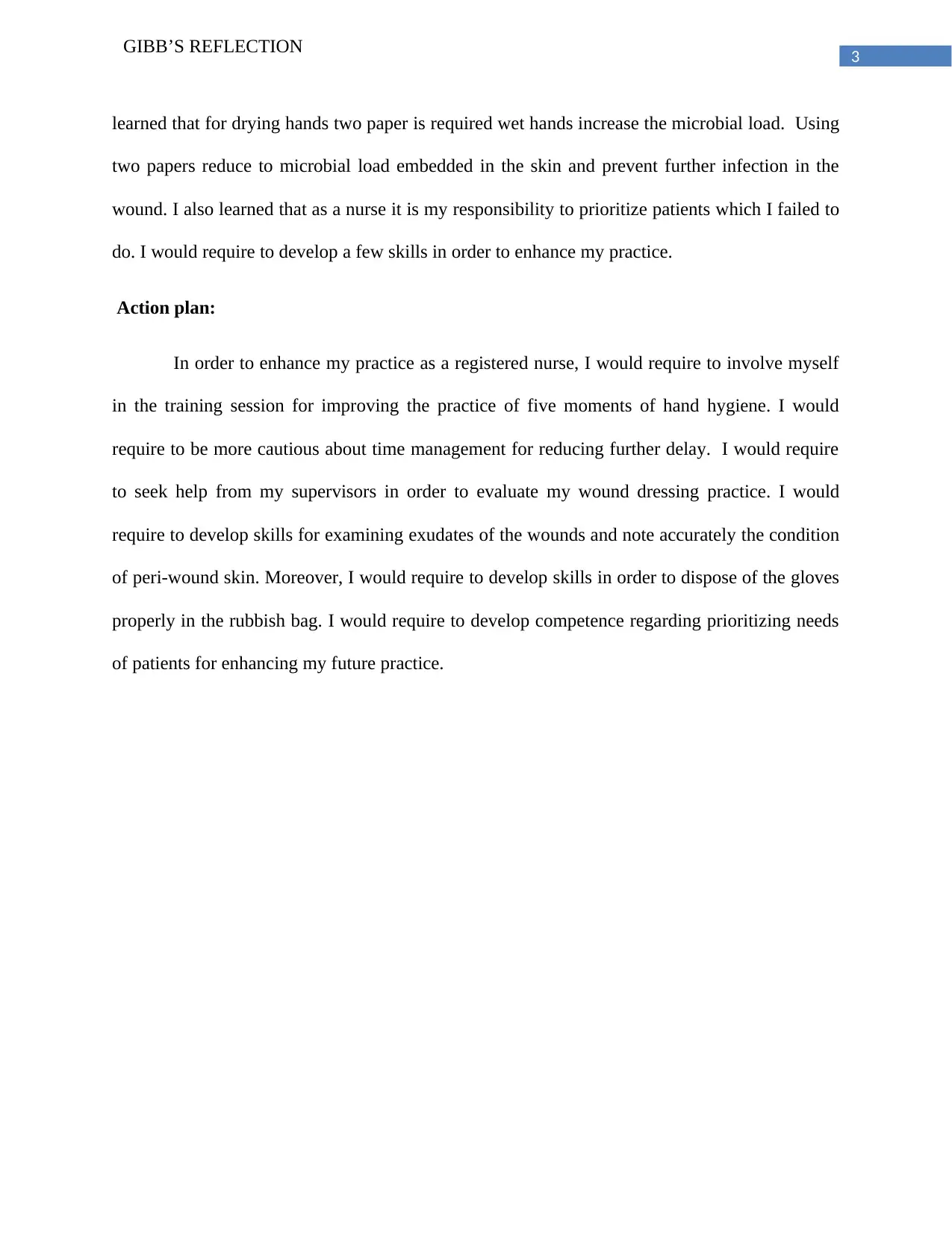
3
GIBB’S REFLECTION
learned that for drying hands two paper is required wet hands increase the microbial load. Using
two papers reduce to microbial load embedded in the skin and prevent further infection in the
wound. I also learned that as a nurse it is my responsibility to prioritize patients which I failed to
do. I would require to develop a few skills in order to enhance my practice.
Action plan:
In order to enhance my practice as a registered nurse, I would require to involve myself
in the training session for improving the practice of five moments of hand hygiene. I would
require to be more cautious about time management for reducing further delay. I would require
to seek help from my supervisors in order to evaluate my wound dressing practice. I would
require to develop skills for examining exudates of the wounds and note accurately the condition
of peri-wound skin. Moreover, I would require to develop skills in order to dispose of the gloves
properly in the rubbish bag. I would require to develop competence regarding prioritizing needs
of patients for enhancing my future practice.
GIBB’S REFLECTION
learned that for drying hands two paper is required wet hands increase the microbial load. Using
two papers reduce to microbial load embedded in the skin and prevent further infection in the
wound. I also learned that as a nurse it is my responsibility to prioritize patients which I failed to
do. I would require to develop a few skills in order to enhance my practice.
Action plan:
In order to enhance my practice as a registered nurse, I would require to involve myself
in the training session for improving the practice of five moments of hand hygiene. I would
require to be more cautious about time management for reducing further delay. I would require
to seek help from my supervisors in order to evaluate my wound dressing practice. I would
require to develop skills for examining exudates of the wounds and note accurately the condition
of peri-wound skin. Moreover, I would require to develop skills in order to dispose of the gloves
properly in the rubbish bag. I would require to develop competence regarding prioritizing needs
of patients for enhancing my future practice.
Paraphrase This Document
Need a fresh take? Get an instant paraphrase of this document with our AI Paraphraser
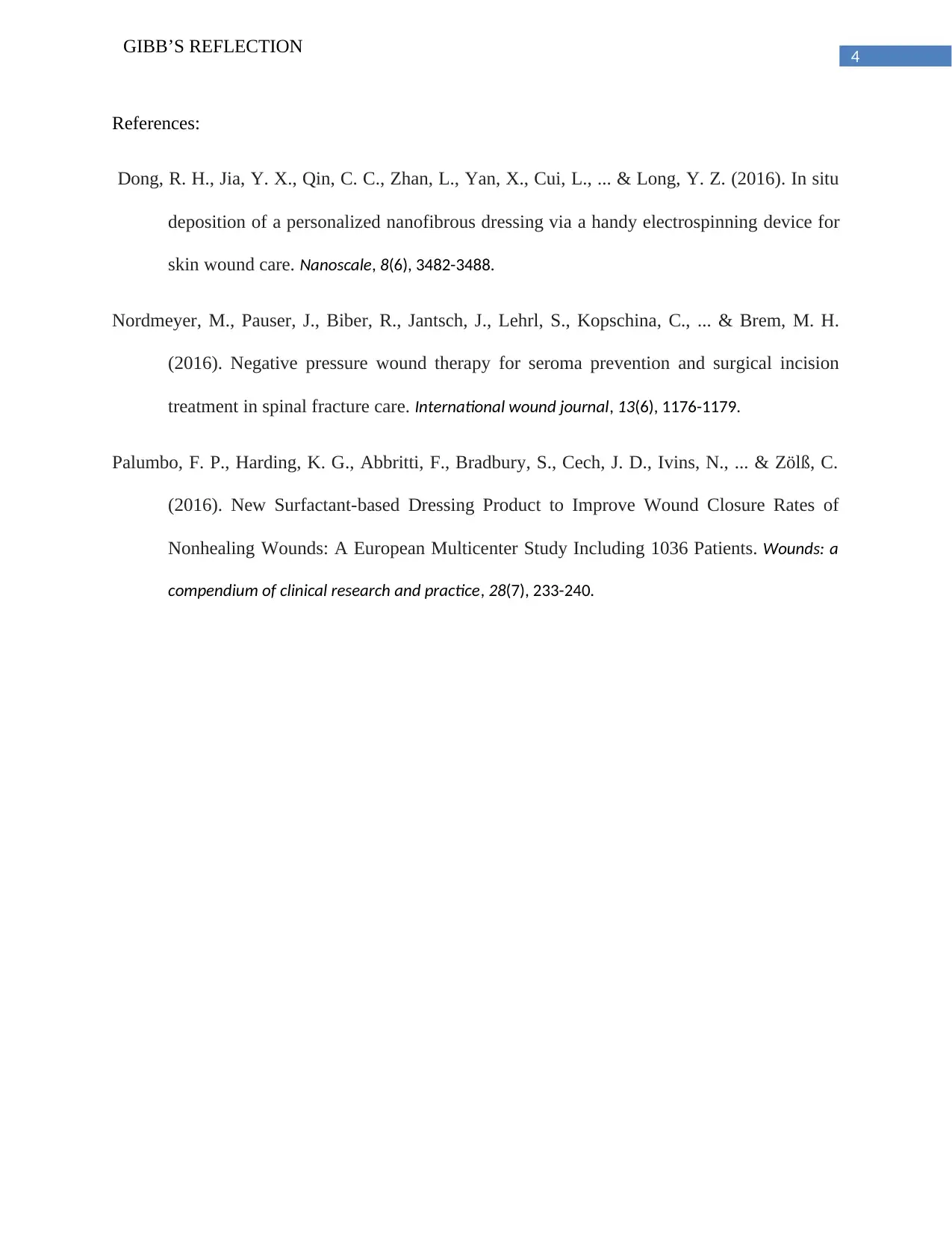
4
GIBB’S REFLECTION
References:
Dong, R. H., Jia, Y. X., Qin, C. C., Zhan, L., Yan, X., Cui, L., ... & Long, Y. Z. (2016). In situ
deposition of a personalized nanofibrous dressing via a handy electrospinning device for
skin wound care. Nanoscale, 8(6), 3482-3488.
Nordmeyer, M., Pauser, J., Biber, R., Jantsch, J., Lehrl, S., Kopschina, C., ... & Brem, M. H.
(2016). Negative pressure wound therapy for seroma prevention and surgical incision
treatment in spinal fracture care. International wound journal, 13(6), 1176-1179.
Palumbo, F. P., Harding, K. G., Abbritti, F., Bradbury, S., Cech, J. D., Ivins, N., ... & Zölß, C.
(2016). New Surfactant-based Dressing Product to Improve Wound Closure Rates of
Nonhealing Wounds: A European Multicenter Study Including 1036 Patients. Wounds: a
compendium of clinical research and practice, 28(7), 233-240.
GIBB’S REFLECTION
References:
Dong, R. H., Jia, Y. X., Qin, C. C., Zhan, L., Yan, X., Cui, L., ... & Long, Y. Z. (2016). In situ
deposition of a personalized nanofibrous dressing via a handy electrospinning device for
skin wound care. Nanoscale, 8(6), 3482-3488.
Nordmeyer, M., Pauser, J., Biber, R., Jantsch, J., Lehrl, S., Kopschina, C., ... & Brem, M. H.
(2016). Negative pressure wound therapy for seroma prevention and surgical incision
treatment in spinal fracture care. International wound journal, 13(6), 1176-1179.
Palumbo, F. P., Harding, K. G., Abbritti, F., Bradbury, S., Cech, J. D., Ivins, N., ... & Zölß, C.
(2016). New Surfactant-based Dressing Product to Improve Wound Closure Rates of
Nonhealing Wounds: A European Multicenter Study Including 1036 Patients. Wounds: a
compendium of clinical research and practice, 28(7), 233-240.
1 out of 5
Related Documents
Your All-in-One AI-Powered Toolkit for Academic Success.
+13062052269
info@desklib.com
Available 24*7 on WhatsApp / Email
![[object Object]](/_next/static/media/star-bottom.7253800d.svg)
Unlock your academic potential
Copyright © 2020–2025 A2Z Services. All Rights Reserved. Developed and managed by ZUCOL.




